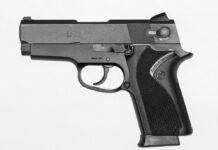What is point shooting? Broadly, it’s the practice of shooting, usually a handgun, where the user doesn’t reference a traditional sight picture and instead stays focused on the target. It’s an interesting technique that was developed to deal with a specific issue, but has stuck around in the modern era.
To get a better answer to the question of what is point shooting, you have to go back to the years between World War 1 and World War 2. The fathers of point shooting, William Fairbairn and Eric Sykes, developed their method of point shooting to solve the marksmanship issues they were dealing with on the Shanghai Police force. At that time, pistols were still shot primarily with one hand, and the sights on all pistols of that era were…tragic. Trying to get a good sight picture on a gun with microscopic sights would be difficult, especially under stress. The Fairbairn-Sykes technique was refined on by Rex Applegate, and is commonly referenced today as the FSA method of point shooting.
The second piece of the “what is point shooting” puzzle comes from the FBI, who for years taught the FBI 1/2 Hip method of shooting. In this style of point shooting, the shooter crouches, and with a bent elbow fires the pistol from below the eyeline, again with one arm. A shooter using the 1/2 Half Hip evokes images of old western gunslingers.
In current times, an updated system of point shooting uses a two-handed grip, and incorporates a “startle response” into the process. In this instance, the method is based around the belief that shooters will have the same “startle” reaction to danger, and will all adopt a crouched posture. This method of point shooting utilizes a dropped head position, fully extended arms, and does not reference the gun to aim.
Of course, defining what is point shooting doesn’t help understand its modern relevance. First, we have to look at how aiming the gun is defined. Very broadly, there are three types of sight pictures: the gross index, the flash sight picture, and the hard sight picture. The gross index is actually used by the FSA method, where the gun itself is superimposed in the shooter’s line of vision and used as an aiming index to get hits. The flash sight picture is a quick picture of the front sight in relation to the rear sights, and as long as it’s acceptable based on the target, the shot is fired. It’s important to note that with training, a flash sight picture can be accomplished while remaining target focused. Finally, the precise sight picture – the perfect “equal height equal light” NRA-approved sight picture. It’s also worth noting that a red dot obviates the need for a flash sight picture, and the shooter can be target focused at all times.
While I was unpacking the riddle all this, I decided to take the three point shooting techniques to the range and test them against a shot timer and modern aiming methods. In all cases, aiming the gun produced better results for speed and accuracy than all point shooting methods. However, the FSA method produced the best results of all point shooting methods. Ultimately, I think that there are legitimate reasons where one might want or need to employ a point shooting technique, it’s not something that needs to be specifically trained for. I was able to produce solid point shooting results, and I’ve never trained to do it. I have trained to aim the gun…and that’s going to give you better results, regardless.



